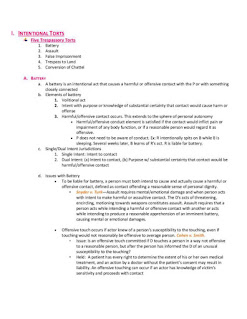Law School Torts Outline - A Comprehensive Guide
When it comes to the study of law, torts are an essential subject that every law student needs to master. Understanding the principles and intricacies of tort law is crucial for a successful legal career. To help you navigate this complex field, we have prepared a comprehensive torts outline that covers the key concepts, elements, and case precedents commonly encountered in law school.
Introduction to Torts
Tort, derived from the Latin word tortus meaning "wrong," refers to civil wrongdoings that cause harm or injury to an individual, leading to legal liability for the wrongdoer. Tort law aims to provide compensation for victims and deter potential wrongdoers from engaging in harmful activities.
Elements of a Tort
There are four essential elements that must be established in a tort claim:
- Duty of Care: The defendant owed a legal duty of care to the plaintiff.
- Breach of Duty: The defendant breached that duty of care.
- Causation: There is a causal connection between the defendant's breach of duty and the plaintiff's harm.
- Damages: The plaintiff suffered actual damages as a result of the defendant's actions.
Types of Torts
Torts can be classified into three main categories:
- Intentional Torts: These are torts where the defendant acted intentionally to cause harm or injury to the plaintiff. Examples include assault, battery, defamation, and trespassing.
- Negligence: Negligence occurs when a person fails to exercise reasonable care, resulting in harm to another. Elements of negligence usually include duty, breach, causation, and damages.
- Strict Liability: Strict liability torts are those where the defendant is held liable for an injury regardless of fault or intent. These often involve dangerous activities or defective products.
Defenses to Tort Liability
There are several defenses that a defendant may raise to avoid tort liability:
- Contributory Negligence: If the plaintiff contributed to their own injury through negligent behavior, their compensation may be reduced or denied.
- Comparative Fault: The damages awarded to the plaintiff are reduced by their degree of fault in causing the injury.
- Assumption of Risk: When the plaintiff voluntarily engages in a risky activity and is aware of the potential harm, they may be deemed to have assumed the risk.
Important Tort Case Precedents
Studying significant tort cases is crucial as they establish legal precedents and shape the interpretation of tort law. Some famous tort cases include:
- The Palsgraf v. Long Island Railroad Co. (1928) case, which focused on the concept of proximate cause.
- The Stella Liebeck v. McDonald's Restaurants (1992) case, known for the controversial "hot coffee" lawsuit.
- The Pearson v. Dodd (1969) case, which clarified the scope of immunity granted to legislators.
By familiarizing yourself with these cases, you will gain a deeper understanding of legal principles and how they apply in real-world scenarios.
Remember to consult your law school and textbooks for a more comprehensive and detailed torts outline, as our guide provides a brief overview to assist you in your studies.

No comments:
Post a Comment